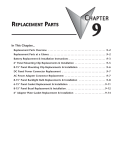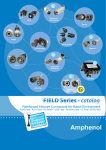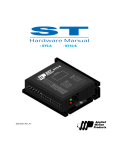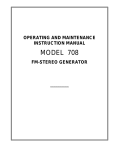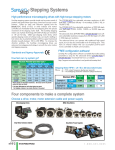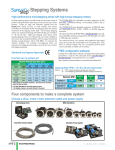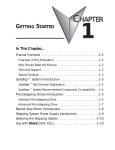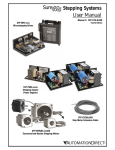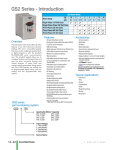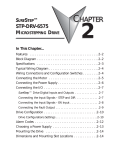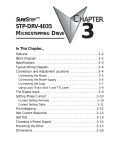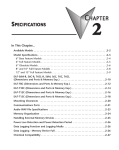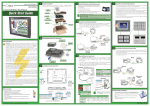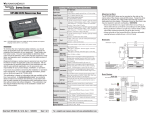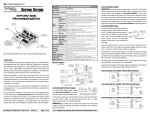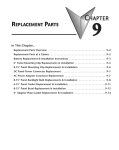Download Chapter 4 - AutomationDirect
Transcript
SURESTEP™ ADVANCED MICROSTEPPING DRIVES CHAPTER 4 In This Chapter... Features . . . . . . . . . . . . . . . . . . . . . . . . . . . . . . . . . . . . . . .4–2 Specifications . . . . . . . . . . . . . . . . . . . . . . . . . . . . . . . . . . .4–3 Typical Wiring Diagram . . . . . . . . . . . . . . . . . . . . . . . . . . . .4–4 Connection Locations & Pin-out . . . . . . . . . . . . . . . . . . . . .4–4 Connecting the Motor . . . . . . . . . . . . . . . . . . . . . . . . . . . .4–5 Connecting the Power Supply . . . . . . . . . . . . . . . . . . . . . . .4–6 Connecting the I/O . . . . . . . . . . . . . . . . . . . . . . . . . . . . . . .4–7 SureStep™ Drive Digital Inputs . . . . . . . . . . . . . . . . . . . . . . . . .4–7 Connecting STEP and DIR to 5V TTL Logic . . . . . . . . . . . . . . . .4–7 Connecting STEP and DIR to Logic Other Than 5V TTL Level . . .4–8 Connections to the EN Input . . . . . . . . . . . . . . . . . . . . . . . . . . .4–9 Connecting the Analog Input . . . . . . . . . . . . . . . . . . . . . . . . .4–10 Connecting the Digital Output . . . . . . . . . . . . . . . . . . . . . . . .4–10 Drive Configuration . . . . . . . . . . . . . . . . . . . . . . . . . . . . . .4–11 SureStep™ Pro Software . . . . . . . . . . . . . . . . . . . . . . . . . .4–13 Choosing a Power Supply . . . . . . . . . . . . . . . . . . . . . . . . .4–16 Mounting the Drive . . . . . . . . . . . . . . . . . . . . . . . . . . . . .4–17 Dimensions and Mounting Slot Locations . . . . . . . . . . . . .4–17 Chapter 4: SureStep™ Advanced Microstepping Drives Features • Max 5A, 48V and max 10A, 80V models available • Software configurable • Programmable microsteps • Internal indexer (via ASCII commands) • Self test feature • Idle current reduction • Anti-resonance • Torque ripple smoothing • Step, analog, & serial communication inputs 4–2 SureStepTM Stepping Systems User Manual Fourth Edition 12/2012 Chapter 4: SureStep™ Advanced Microstepping Drives Specifications SureStep™ Series Specifications – Microstepping Drives Microstepping Drive Drive Type Output Current Input Voltage (external p/s required) Configuration Method Amplifier Type Current Control STP-DRV-4850 Protection over-voltage, under-voltage, over-temperature, external output faults (phase-to-phase & phase-to-ground), inter-amplifier shorts Recommended Input Fusing Fuse: 4A 3AG delay (ADC #MDL4) Fuse Holder: ADC #DN-F6L110 Input Circuit Step/Pulse Input Signals Direction Enable Analog Output Signal Communication Interface Non-volatile Memory Storage Idle Current Reduction Microstep Resolution Modes of Operation Phase Current Setting Features Self Test Additional Features Connectors Maximum Humidity Storage Temperature Operating Temperature Drive Cooling Method Mounting Dimensions Weight Agency Approvals Fourth Edition 12/2012 STP-DRV-80100 Advanced microstepping drive with pulse or analog input, serial communication, & indexing capability 0.1–5.0 A/phase (in 0.01A increments) 0.1–10.0 A/phase (in 0.01A increments) 24–48 VDC (nominal) (range: 18-53 VDC) 24–80 VDC (nominal) (range: 18-88 VDC) SureStep Pro software (included) MOSFET, dual H-bridge, 4-quadrant 4-state PWM @ 20 kHz Fuse: 6.25A 3AG delay (ADC #MDL6-25) Fuse Holder: ADC #DN-F6L110 Opto-coupler input with 5 to 15 mA input current; Logic Low is input pulled to 0.8 VDC or less; Logic High is input 4 VDC or higher. optically isolated, differential, 5V, 330Ω; min pulse width = 250 ns max pulse frequency = 2MHz adjustable bandwidth digital noise rejection feature FUNCTIONS: step & direction, CW/CCW step, A/B quadrature, run/stop & direction, jog CW/CCW, CW/CCW limits optically isolated, 5–12V, 680Ω; FUNCTIONS: motor enable, alarm reset, speed select (oscillator mode) Range: 0–5 VDC; Resolution: 12 bit; FUNCTION: speed control optically isolated, 24V, 10 mA max; FUNCTIONS: fault, motion, tach RS-232; RJ11 (6P4C) receptacle Configurations are saved in FLASH memory on-board the DSP. reduction range of 0–90% of running current after delay selectable in ms software selectable from 200 to 51200 steps/rev in increments of 2 steps/rev pulse (step) & direction, CW/CCW, A/B quadrature, velocity (oscillator), SCL serial commands 0.1–5.0 A/phase (in 0.01A increments) 0.1–10.0 A/phase (in 0.01A increments) checks internal & external power supply voltages, diagnoses open motor phases Anti-resonance (Electronic Damping) Auto setup Serial Command Language (SCL) Host Control Step Smoothing Filter (Command Signal Smoothing & Microstep Emulation) Waveform (Torque Ripple) Smoothing Communication: RJ11 (6P4C); Other: removable screw terminal blocks 90% non-condensing -20–80 °C [-4–176 °F] (mount to suitable heat sink) 0–55 °C [32–158 °F] (mount to suitable heat sink) natural convection (mount to suitable heat sink) #6 mounting screws (mount to suitable heat sink) 3.0 x 3.65 x 1.125 inches [76.2 x 92.7 x 28.6 mm] 8 oz [227g] (approximate) CE, RoHS SureStepTM Stepping Systems User Manual 4–3 Chapter 4: SureStep™ Advanced Microstepping Drives Typical Wiring Diagram Logic Motor Power Power 5VDC xx VDC Step Motor Power Supply SureStep Typical Wiring Diagram – VDC + + VDC – A+ A– STPDRV-xxxx B+ STP-PWR-xxxx B– Cable Color Code Term Wire Pin # A+ Red 1 A– White 2 B+ Green 3 B– Black 4 Stepper Drive Extension Cable 12" Motor Pigtail with Connector with Connector STP-EXT(H)-020 Step Motor STP-MTR(H)-xxxxx Connection Locations & Pin-out Removable Terminals: ELVP06100 햾 – EN햿 – EN+ 헀 – DIR헁 – DIR+ 헂 – STEP헃 – STEP+ Ground Terminal (not visible) ELVP05100 햸 – GND 햹 – AIN 햺 – +5V 햻 – Out햽 – Out+ ELFP06210 햲 – V+ (Power) 햳 – V- (GND) 햴 – A+ (Motor) 햵 – A- (Motor) 햶 – B+ (Motor) 햷 – B- (Motor) Removable Terminal Blocks For Wiring Status LEDs RS-232 Communication Interface Terminal block part #s (shown) are Amphenol PCD (www.amphenolpcd.com) RS-232 Comm Port: (RJ11 6P4C) 햶 – RX 햵 – no connection 햴 – TX 햳 – GND 4–4 External wiring is connected using three separate pluggable screw terminal connectors. The power connections share a six position connector, the digital inputs share another six position connector, and the analog input and digital output share a five position connector. SureStepTM Stepping Systems User Manual Fourth Edition 12/2012 Chapter 4: SureStep™ Advanced Microstepping Drives Connecting the Motor Warning: When connecting a step motor to a SureStep™ advanced microstepping drive, be sure that the motor power supply is switched off. When using a motor not supplied by AutomationDirect, secure any unused motor leads so that they can't short out to anything. Never disconnect the motor while the drive is powered up. Never connect motor leads to ground or to a power supply. (See the Typical Wiring Diagram shown in this chapter for the step motor lead color code of AutomationDirect supplied motors.) Four lead motors Four lead motors can only be connected one way, as shown below. A+ A– Red 4 lead motor White Green Black B+ B– 4 Leads All AutomationDirect SureStep™ motors are four lead bipolar step motors. Six lead motors Six lead motors can be connected in series or center tap. Motors produce more torque at low speeds in series configuration, but cannot run as fast as in the center tap configuration. In series operation, the motor should be operated at 30% less than rated current to prevent overheating. Grn/Wht A– n/c A+ A– 6 lead motor White A+ Green n/c Red Black B– n/c Red/ Wht B+ 6 Leads Series Connected Grn/Wht 6 lead motor White Green Red Black B– B+ Red/ Wht n/c 6 Leads Center Tap Connected Step motor wire lead colors vary from one manufacturer to another. Fourth Edition 12/2012 SureStepTM Stepping Systems User Manual 4–5 Chapter 4: SureStep™ Advanced Microstepping Drives Eight lead motors Eight lead motors can also be connected in two ways: series or parallel. Series operation gives you more torque at low speeds, but less torque at high speeds. When using series connection, the motor should be operated at 30% less than the rated current to prevent over heating. Parallel operation allows greater torque at high speeds. When using parallel connection, the current can be increased by 30% above rated current. Care should be taken in either case to assure the motor does not being overheat. Orange A+ Blk/ Wht Orange A+ Org/Wht 8 lead motor Blk/Wht A– 8 lead motor Org/ Wht A– Black Black Red Red/ Wht B+ Yel/ Wht Yellow Red Yellow B– B+ 8 Leads Series Connected Yel/ Wht Red/ Wht B– 8 Leads Parallel Connected Step motor wire lead colors vary from one manufacturer to another. Connecting the Power Supply An STP-PWR-xxxx power supply from AutomationDirect is the best choice to power the step motor drive. If you need information about choosing a different power supply, refer to the section entitled “Choosing a Power Supply” in this chapter. If your power supply does not have a fuse on the output or some kind of short circuit current limiting feature, you need a fuse between the drive and the power supply. Install the fuse on the + power supply lead. + Fuse * VDC – Step Motor – Power Supply + VDC * External fuse not req'd when using an STP-PWR-xxxx P/S; fuse is internal. Warning: Connect the motor power supply "+" terminal to the drive "+ VDC" terminal, and connect the power supply "–" terminal to the drive "VDC–" terminal. Use wire no smaller than 18 gauge, and be careful not to reverse the wires. Reverse connection will destroy your drive and void the warranty. 4–6 SureStepTM Stepping Systems User Manual Fourth Edition 12/2012 Chapter 4: SureStep™ Advanced Microstepping Drives Connecting the I/O SureStep™ Drive Digital Inputs The SureStep advanced drives include two high speed 5V digital inputs (STEP and DIR), and one standard speed 5-12V input (EN). Internal to the STP-DRV-xxxx 330액 STEP+ 220pF STEP– 330액 DIR+ 220pF DIR– 680액 EN+ The digital inputs are optically isolated to reduce electrical noise problems. There is no electrical connection between the control and power circuits within the drive, and input signal communication between the two circuits is achieved by infrared light. Externally, the drive’s motor power and control circuits should be supplied from separate sources, such as from a step motor power supply with separate power and logic outputs. For bidirectional rotation, supply a source of step pulses to the drive at the STEP+ and STEP– terminals, and a directional signal at the DIR+ and DIR– terminals. EN– Drive Digital Input Circuit The ENABLE input allows the logic to turn off the current to the step motor by providing a signal to the EN+ and EN– terminals. The EN+ and EN– terminal can be left unconnected if the enable function is not required. All logic inputs can be controlled by a DC output signal that is either sinking (NPN), sourcing (PNP), or differential. Connecting STEP and DIR to 5V TTL Logic Connecting to an Indexer with Sinking Outputs +5V OUT Indexer with Sinking Outputs DIR DIR+ DIR– STP-DRV-xxxx Drive STEP+ EN+ STEP– EN– N/C STEP N/C Connecting to an Indexer with Sourcing Outputs Indexer with Sourcing Outputs COM DIR– DIR DIR+ STP-DRV-xxxx Drive STEP– EN+ STEP+ EN– N/C STEP N/C Fourth Edition 12/2012 SureStepTM Stepping Systems User Manual 4–7 Chapter 4: SureStep™ Advanced Microstepping Drives Connecting to an Indexer with Differential Outputs DIR+ DIR+ Indexer DIR– with Differential Outputs STEP+ DIR– STP-DRV-xxxx Drive STEP+ EN+ STEP– EN– N/C STEP– N/C Many high speed indexers have differential outputs. Wiring for Encoder Following Master Encoder A+ X1/STEP+ A– X1/STEP– B+ X2/DIR+ EN+ B– X2/DIR– EN– STP-DRV-xxxx Drive N/C N/C Connecting STEP and DIR to Logic Other Than 5V TTL Level Some step and direction signals, especially those of PLCs, don't use 5 volt logic. You can connect signal levels as high as 24 volts to a SureStep advanced drive if you add external dropping resistors to the STEP, DIR and EN inputs. • For 12V logic, use 820Ω, 1/4W resistors • For 24V logic, use 2200Ω, 1/4W resistors Most PLCs can use 24 VDC Logic. Warning: 5VDC is the maximum voltage that can be applied directly to a high speed input (STEP and DIR). If using a higher voltage power source, install resistors to reduce the voltage at the inputs. Do NOT apply an AC voltage to an input terminal. Connecting to an Indexer with Sink or Source 12-24 VDC Outputs DIR+ +12-24V Indexer with Sinking Outputs ENABLE STP-DRV-xxxx DIR– Drive DIR R STEP R R 4–8 STEP+ EN+ STEP– EN– Indexer with Sourcing Outputs ENABLE (If enable function is used) SureStepTM Stepping Systems User Manual COM DIR– DIR DIR+ R STEP R R STP-DRV-xxxx Drive STEP– EN– STEP+ EN+ (If enable function is used) Fourth Edition 12/2012 Chapter 4: SureStep™ Advanced Microstepping Drives Connecting to a PLC with Sink or Source 12-24 VDC Outputs – + PLC with Sinking Outputs ENABLE DIR+ +12-24V STP-DRV-xxxx DIR– Drive DIR R STEP STEP+ R R – + +12-24V 12 - 24 VDC COM PLC with Sourcing Outputs EN+ STEP– COM EN– ENABLE 12-24 VDC DIR– DIR+ DIR R R STEP R (If enable function is used) STP-DRV-xxxx Drive STEP– EN– STEP+ EN+ (If enable function is used) Connecting to Mechanical Switches at 24 VDC + DIR+ direction switch +24VDC Power Supply run/stop switch (closed = run) - DIR- 2200액 STEP+ STP -DRV -xxxx Drive STEP- 2200액 Connections to the EN Input The ENABLE input allows the user to turn off the current to the motor by providing a 5-12 VDC positive voltage between EN+ and EN-. The logic circuitry continues to operate, so the drive "remembers" the step position even when the amplifiers are disabled. However, the motor may move slightly when the current is removed depending on the exact motor and load characteristics. Warning: 12VDC is the maximum voltage that can be applied directly to the standard speed EN input. If using a higher voltage power source, install resistors to reduce the voltage at the input. Do NOT apply an AC voltage to an input terminal. Connecting ENABLE Input to Relay or Switch + 5-12VDC Power Supply EN+ switch or relay (closed = logic low) - STP-DRV-xxxx Drive EN- Connecting ENABLE Input to NPN Proximity Sensor + 5-12VDC Power Supply Fourth Edition 12/2012 EN+ + - output NPN Proximity Sensor EN- STP-DRV-xxxx Drive SureStepTM Stepping Systems User Manual 4–9 Chapter 4: SureStep™ Advanced Microstepping Drives Connecting ENABLE Input to PNP Proximity Sensor + + 5-12VDC Power Supply - - EN+ output PNP Proximity Sensor STP-DRV-xxxx Drive EN- Leave the ENABLE input unconnected if you do not need to disable the amplifiers. Connecting the Analog Input The SureStep advanced drives have one 0-5 VDC analog input. Connecting AI to Analog Signal 0-5V signal STP-DRV-xxxx Drive Internal to the STP-DRV-xxxx +5V +5VDC, 10mA max 330액 AIN 220pF AIN signal return GND Connecting AI to Potentiometer +5V GND Drive Analog Input Circuit 1-10k액 potentiometer AIN GND STP -DRV -xxxx Drive Warning: The analog input is NOT optically isolated, and must be used with care. It may operate improperly and it can be damaged if the system grounds are not compatible. Connecting the Digital Output The SureStep advanced drives have one digital output that has separate + and terminals, and can be used to sink or source current. Connecting DO to Inductive Load relay coil (inductive load) Internal to the STP-DRV-xxxx OUT+ OUT– Drive Digital Output Circuit 4–10 + OUT+ STP-DRVxxxx Drive OUT- SureStepTM Stepping Systems User Manual 1N4935 suppression diode 5-24 VDC Power Supply - Fourth Edition 12/2012 Chapter 4: SureStep™ Advanced Microstepping Drives Connecting DO as Sinking Output + Load OUT+ 5-24 VDC Power Supply STP-DRVxxxx Drive Connecting DO as Sourcing Output 5-24 VDC Power Supply STP-DRVxxxx Drive - OUT- + OUT+ OUT- Load - Warning: Do NOT connect the digital output to a voltage greater than 30 VDC. The current through each DO terminal must not exceed 10 mA. Drive Configuration You need to configure your drive for your particular application before using the drive for the first time. The SureStep advanced microstepping drives include a CD containing SureStep™ Pro drive configuration software for this purpose. The software contains instructions for installation on a PC, and instructions for configuring the drives. Configuration settings include: • drive model • motor characteristics • motion control mode • I/O configuration Anti-Resonance / Electronic Damping Step motor systems have a tendency to resonate at certain speeds. SureStep advanced drives automatically calculate the system’s natural resonate frequency, and apply damping to the control algorithm. This greatly improves midrange stability, allows higher speeds and greater torque utilization, and improves settling times. This feature is on by default, but it can be turned off using the “Motor...” icon of the SureStep Pro software. Idle Current Reduction This feature reduces current consumption while the system is idle, and subsequently reduces drive and motor heating. However, reducing the idle current also reduces the holding torque. The percent and delay time of the idle current reduction can be adjusted using the “Motor...” icon of the SureStep Pro software. Microstep Resolution The microstep resolution (steps/rev) can be selected using the “Motion & I/O...” icon of the SureStep Pro software, and selecting “Pulse and Direction Mode”. Fourth Edition 12/2012 SureStepTM Stepping Systems User Manual 4–11 Chapter 4: SureStep™ Advanced Microstepping Drives Modes of Operation Modes of operation are selectable via the SureStep Pro software “Motion & I/O...” icon. • Pulse & Direction Mode • Pulse & Direction • CW & CCW Pulse • A/B Quadrature • Velocity (Oscillator) Mode • Serial Command Language (SCL) Phase Current Setting Motor phase current settings are available through the SureStep Pro software “Motor...” icon and the “Running Current” settings. Serial Command Language (SCL) Host Control SureStep advanced drives can accept serial commands from a host PC or PLC. This feature can be selected using the “Motion & I/O...” icon of the SureStep Pro software, and selecting Serial Command Language. Step Smoothing Filter (Command Signal Smoothing & Microstep Emulation) The Step Smoothing Filter setting is effective only in the Step (Pulse) & Direction mode. It includes command signal smoothing and microstep emulation to soften the effect of immediate changes in velocity and direction, therefore making the motion of the motor less jerky. An added advantage is that it can reduce the wear on mechanical components. This feature can be modified by using the “Motion & I/O...” icon of the SureStep Pro software, and selecting “Pulse and Direction Mode”. Waveform (Torque Ripple) Smoothing All step motors have an inherent low speed torque ripple that can affect the motion of the motor. SureStep advanced drives can analyze this torque ripple and apply a negative harmonic to negate this effect. This feature gives the motor much smoother motion at low speeds. This feature is on by default, and is factory preset for standard motors. It can be turned off or on using the “Motor...” icon of the SureStep Pro software. To set Waveform Smoothing for custom motors, select “Define Custom Motor...” and the “Waveform Smoothing” “Wizard...”. 4–12 SureStepTM Stepping Systems User Manual Fourth Edition 12/2012 Chapter 4: SureStep™ Advanced Microstepping Drives SureStep™ Pro Software The SureStep advanced drives STP-DRV-4850 & -80100 are configured using SureStep Pro™ configuration software, which is included on CD with the drive. The software is divided into two major sections, “Motion and I/O” and “Motor” configuration. There are also communication settings, drive selection, and drive status features. • Runs on Windows 98, 2000, ME, NT, Vista, XP. Complete software instructions are included in the “Help” files within the software. Communication: Upload and Download from/to the drive. When you connect to a drive, the Motor, Motion Mode, and Dedicated I/O settings that are currently in the drive will appear on the right of the screen (as will the Drive and Revision at the top of the screen). “Upload from Drive” to get all the configuration settings from the drive or “Download to Drive” to apply all the settings on the PC to the drive. Fourth Edition 12/2012 SureStepTM Stepping Systems User Manual 4–13 Chapter 4: SureStep™ Advanced Microstepping Drives Motor Configuration: Clicking on the “Motor..” icon will bring up the motor configuration screen. You can choose a motor from the pull-down menu or enter a custom motor (you will need to enter that motor’s specific information). If you know the inertia mismatch of the load, you should enter it. If the inertia mismatch is unknown, this entry can be left at 1. The idle current is default at 50%. Idle current should be used unless the application will require a constant high holding torque Motion and I/O: Selecting this tab will allow you to set the drive’s mode of operation. • Pulse and Direction: Used with high-speed pulse inputs (CW/CCW, Pulse/Direction, Quadrature) generated from a PLC, encoder, etc. • Velocity (Oscillator): Allows the drive to be speed controlled by an analog signal. The input is 0 – 5V and can be scaled to the desired maximum speed. Bidirectional motion can be attained by changing the Offset (under “Advanced Analog Settings”) to a non-zero value. EX: Setting this value to 2500mV will command the drive to be at zero speed when 2.5V are present. • Serial Command Language (SCL): Causes the drive to respond to serial commands. A PLC or PC can issue a variety of commands to enable simple motion, gearing/following, turn on the output, wait for an input, etc. See the “SCL Manual” under the SureStep Pro Help menu. Serial commands can be tested by selecting the “Drive” pull-down menu from the menu bar, and then selecting “SCL Terminal”. 4–14 SureStepTM Stepping Systems User Manual Fourth Edition 12/2012 Chapter 4: SureStep™ Advanced Microstepping Drives Drive Pull-down Menu: This software menu gives you several features to monitor and test the drive. • Alarm History – Will read back the most recent drive faults • Clear Alarm – Will clear the current drive fault. • Restore Factory Defaults – resets the drive to “out of the box” status. • SCL Terminal – Allows SCL commands to be tested by typing them in. (HyperTerminal is NOT a good tool for serial commands, because the drive will “time-out” if you use HyperTerminal to enter strings. SCL Terminal will send the entire string at once.) • Self-Test – Rotates the motor clockwise and counterclockwise. (Tests motor and cabling) • Status Monitor – Shows the current Drive and I/O status. • Set Quick Decel Rate – Used when the drive encounters faults or overtravel limits. Fourth Edition 12/2012 SureStepTM Stepping Systems User Manual 4–15 Chapter 4: SureStep™ Advanced Microstepping Drives Choosing a Power Supply Voltage Chopper drives work by switching the voltage to the motor terminals on and off while monitoring current to achieve a precise level of phase current. To do this efficiently and silently, you'll want to have a power supply with a voltage rating at least five times that of the motor. Depending on how fast you want to run the motor, you may need even more voltage. Generally, more is better; the upper limit being the maximum voltage rating of the drive itself. If you choose an unregulated power supply, do not allow the “no load” voltage to exceed the maximum voltage rating of the drive. Unregulated supplies are rated at full load current. At lesser loads, such as when the motor is not moving, the actual voltage can be up to 1.4 times the voltage list on the power supply label. The STP-PWR-xxxx power supplies are designed to provide maximum voltage while under load, without exceeding the drive’s upper voltage limit when unloaded. Use the “...Recommended Component Compatibilty” chart in the “Chapter 1: Getting Started” to select the appropriate SureStep power supplies for use with SureStep drives. Current The maximum supply current you will need is the sum of the two phase currents. However, you will generally need a lot less than that, depending on the motor type, voltage, speed and load conditions. That's because the SureStep drives use switching amplifiers, converting a high voltage and low current into lower voltage and higher current. The more the power supply voltage exceeds the motor voltage, the less current you'll need from the power supply. We recommend the following selection procedure: 1. If you plan to use only a few drives, choose a power supply with at least twice the rated phase current of the motor. 2. If you are designing for mass production and must minimize cost, get one power supply with more than twice the rated current of the motor. Install the motor in the application and monitor the current coming out of the power supply and into the drive at various motor loads. This test will tell you how much current you really need so you can design in a lower cost power supply. If you plan to use a regulated power supply, you may encounter a problem with current foldback. When you first power up your drive, the full current of both motor phases will be drawn for a few milliseconds while the stator field is being established. After that, the amplifiers start chopping and much less current is drawn from the power supply. If your power supply thinks this initial surge is a short circuit it may "foldback" to a lower voltage. With many foldback schemes the voltage returns to normal only after the first motor step and is fine thereafter. In that sense, unregulated power supplies are better. They are also less expensive. SureStep™ STP-PWR-xxxx power supplies from AutomationDirect are the best choices of DC power supply to use with SureStep™ STP-DRV-xxxx microstepping drives. 4–16 SureStepTM Stepping Systems User Manual Fourth Edition 12/2012 Chapter 4: SureStep™ Advanced Microstepping Drives Mounting the Drive You can mount your drive on the wide or the narrow side of the chassis using #6 screws. Since the drive amplifiers generate heat, the drive should be securely fastened to a smooth, flat metal surface that will help conduct heat away from the chassis. If this is not possible, then forced airflow from a fan may be required to prevent the drive from overheating. • Never use your drive in a space where there is no air flow or where the ambient temperature exceeds 40 °C (104 °F). • When mouting multiple STP-DRV-xxxx drives near each other, maintain at least one half inch of space between drives. • Never put the drive where it can get wet. • Never allow metal or other conductive particles near the drive. Dimensions and Mounting Slot Locations 0.61 [15.5] 1.98 [50.3] SureStep Microstepping Drive STP-DRV-4850 STP-DRV-80100 3.39 [86.1] 3.0 [76.2] 1.125 [28.6] 3.65 [92.7] 6X slot 0.16 [4.1] wide, full R 0.663 [16.8] Fourth Edition 12/2012 DIMENSIONS = in [mm] SureStepTM Stepping Systems User Manual 4–17 Chapter 4: SureStep™ Advanced Microstepping Drives BLANK PAGE 4–18 SureStepTM Stepping Systems User Manual Fourth Edition 12/2012


















